Dynamic Response of Double-Sided Loess Slope under Vehicle Load
LI Peng ,YANG Hucheng ,SU Shengrui and LIU Xiang
1) College of Geology Engineering and Geomatics,Chang’an University,Xi’an 710054,China
2) Open Research Laboratory of Geotechnical Engineering,MLR,Xi’an 710054,China
3) Key Laboratory for Geo-Hazards in Loess Area,MLR,Xi’an 710054,China
4) Architectural Engineering Institute,Yan’an University,Yan’an 716000,Shaanxi,China
In order to verify and study the dynamic response law on the double-sided loess slope under the action of the waves generated by automobile traffic,we select a double-sided loess slope from the long section of Anzi Road as the research object.Both field investigations and on-site monitoring processes are conducted,for the purpose of providing robust basis for road protection in these conditions.In detail,vehicleinduced vibration signals are different according to different vehicle types,speeds,as well as positions,and thus are collected,respectively.Based on the statistical analysis of the signals,the vibration response law and frequency spectrum characteristics of the slope are summarized.The results show that:①The dynamic response of the doublesided loess slope increases as the vehicle load increases,and the strong vibration response area is located in the middle of the side slope; ②When the vehicle load is small,the vibration wave amplification effect is obvious.On the contrary,when the vehicle load is large,the vibration wave amplification effect is weakened; ③The spectrum distribution of the X-direction wave is single-peak shape,and the dominant frequency is concentrated in 30-50 Hz; the frequency spectrum distribution of the Zdirection wave shows a multi-peak shape,and the dominant frequency is concentrated in 20-180 Hz; ④The vibration wave propagates in the slope.The frequency change shows little correlation with the type,speed and position of the vehicle,and instead,it is mainly determined by the slope itself.This study reveals the dynamic response on doubled-sided loess slopes and provides both theoretical and practical significance for the road protection in such situations.
Key words:Vehicle load;Highway slope;Vibration wave;Monitoring;Dynamic response
INTRODUCTION
As a special kind of soil,loess is widely distributed in northern China and typically in the northwestern regions.With the rapidly growing economy in western China,the local infrastructure construction has been unprecedentedly improved,leading to a well-developed transportation system.However,the consequently increased traffic volume has inevitably caused the risk of slope disasters on loess roads.Due to its special topography and geological conditions,the loess area has a wide distribution of geological disasters which may be induced by various influencing factors.Among them,earthquakes,blasting and train loads are the main sources.Fortunately,numerous investigations have been conducted in the loess areas and plenty of valuable information and suggestions have been obtained.(Chen Yongming et al.,2006; Deng Longsheng,2010; Deng Longsheng et al.,2013; Xu Qiang et al.,2010;Chai Hongbao et al.,2011;Zhang Zelin et al.,2016;Li Peng et al.,2013;Li Peng et al.,2015; Chen Ming et al.,2011; Li Junru et al.,2004; Tang Hai et al.,2007,2008; Ma Peng et al.,2014).
With the successive construction and utilization of highways,the influence of traffic load on their stabilityhas attracted more and more attention from scholars.The slope has been in the vibration environment of traffic load for a long time; thus,the strength weakening of the rock and soil will inevitably be aggravated under the repeated action of the traffic load,leading to fatigue failure (Popescu M.,2014).Cai Hancheng et al.(2010) use FLAC2D to numerically simulate the dynamic response of slopes under different types of traffic loads,revealing the slope’s response to different loads and its attenuation laws.Ye Siqiao et al.(2006) simplified the vehicle load into moving dead load and vehicle dynamic load.The calculation shows that for shallow landslides,the stability factor of considering the vehicle load is much lower than the situation of not considering the vehicle load.Jian Wenbin et al.(2008) took a cutting slope as the research object,studied the rock and soil response law under different power input conditions,and rationally evaluated the impact of cyclic loading on rock and soil slopes,and the long-term safety and durability of rock and soil slopes.The analysis has also provided both theoretical and practical values.Yan Zhixin et al.(2015) studied the dynamic response of the road slope supported by bolts,the axial force of bolts,and the acceleration of the slope under traffic loads.Fan Xiufeng et al.(2006) studied the vibration acceleration of soil and rock slopes caused by traffic load as well as its spatial variation characteristics,and used the FFT method to analyze the frequency spectrum of the vibration signal to obtain the vibration response spectrum characteristics of rock and soil slopes.Liang Tiecheng et al.(2003) conducted an experimental study on the vibration of different vehicles on both sides of the highway,and fitted the attenuation law.
A majority of previous studies focus mainly on the dynamic response and stability evaluation of slopes caused by earthquakes and train vibrations; moreover,most studied objects are single-sided slopes whose nature is rock mass and residual slope accumulation.However,in actual investigations,it is found that the more severely damaged highway slopes are isolated double-sided slopes with thin thicknesses,especially loess slopes.However,related research considering the impact of vehicle vibration is limited,resulting in weaknesses and defects of slope disaster protection.Therefore,it is necessary to conduct research on the dynamic response law of double-sided loess slopes under the action of vehicle vibration to provide guidance for highway construction and protection in loess areas.
1 SLOPE OVERVIEW
The studied slope in this paper is located in the Zichang part of Anzi Road,with geographic coordinates of 109°29′13.13″N,37°05′37.72″E.It is a double-sided loess slope adjacent to a highway.The slope is 15.2 m high,30 m wide,and 3 m thick.The south side slope is 60°,and the north side slope is 50° (Fig.1).The slope has a dual structure,with underlying triassic sandstone and upper part of Quaternary Upper Pleistocene aeolian loess (Fig.2),which is characterized by macro pores and vertical joints.Coupled with the effects of plant roots,rainfall and vehicle loads,the structure of the slope has become more fragmented.Meanwhile,different degrees of deformation and damage have occurred.Among them,the vegetation coverage rate of the northern slope is relatively high.The slope is in a high elevation and is affected by the erosion of the valley below,resulting in locally developed landslides sometimes.(Fig.3).The southern slope is mainly characterized by block drop and local collapse(Fig.4).Compared with the surrounding loess slopes with the same type,although all slopes show different degrees of deformation and damage,the slopes near the highway are strongly deformed,and the most severely damaged parts are located in the middle of the slope near the highway.Therefore,it can be seen that although the rock soil conditions are the internal factors that determine slope deformation and failure,several external factors such as rainfall,freezing,and thawing seem to be the dominant inducing factors.In addition,the effect of vehicle load cannot be ignored.
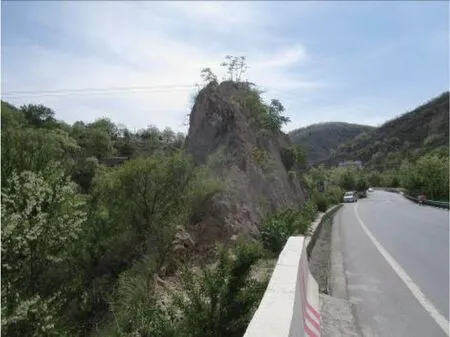
Figure 1 Slope panorama (mirror 95°)
In order to reveal how the vehicle vibration affects the stability of the shallow surface soil of the double-sided loess slope,it is necessary to conduct an in-depth discussion on the dynamic response of the slope under the action of vehicle vibrations.

Figure 2 Slope profile and monitoring component layout

Figure 3 Small slump of the north slope side
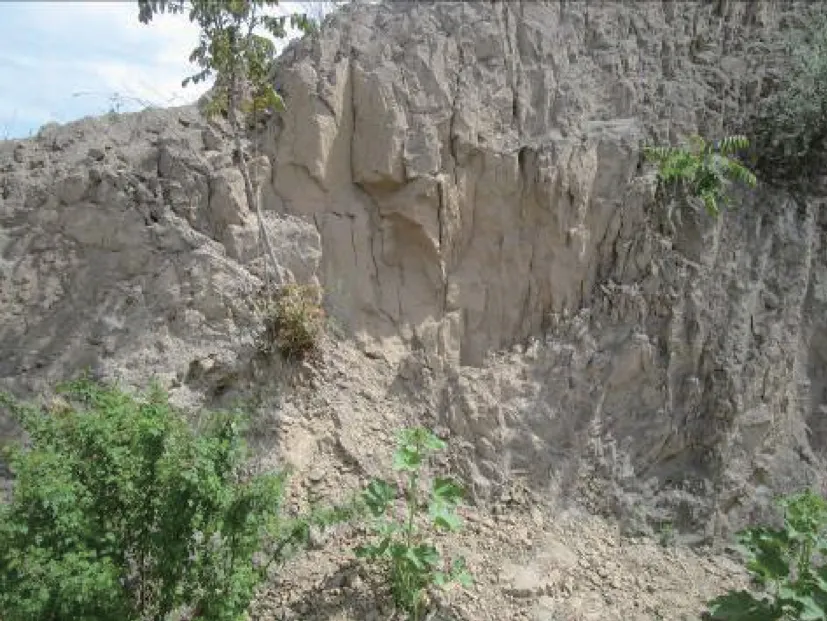
Figure 4 Deformation and fracture on the south slope side
2 SELECTION OF VEHICLE TYPE
In actual situation,the position,speed and time of the running vehicles are random.The difference of these vibration sources will lead to the different amplitude and frequency of the resulting wave inside the slope.The dynamic response of a slope is often controlled by multiple types of vehicles at different speeds and positions,but the regularity of the monitoring data is poor and the research process and results are more complicated.Therefore,the data are collected in a general way in which the waves are generated by various vehicles passing through the slope,thereby reducing the mutual influence between vehicles.Finally,the dynamic response law of the loess slope under the action of vehicle vibration is revealed more systematically.The vehicle type,speed and location on the highway are shown in Table 1.

Table 1 Vehicle load information
3 LAYOUT OF MONITORING EQUIPMENT
The isolated double-sided slope under the action of seismic force often exhibits the“whiplash effect” and the “slope amplification effect”,that is,under the action of strong earthquakes,the seismic response at the top of the slope and the slope surface becomes stronger.Although some people have studied the dynamic response of the slope under the load of the vehicle,the research objects are all single-sided slopes,meaning that there is only one open surface,and the other side is connected to the mountain.Because the dynamic load generated by cars is easily absorbed and dissipated during the propagation process,the attenuation trend against height is often monitored.However,a question raises at the same time.If the slope is low,the shape is also an isolated double-sided slope.Then,how will the vibration wave transmit? In other words,what is the dynamic response of the slope? In order to address the aforementioned problems,enough monitoring equipments should be arranged on both sides and the top of the slope.
For field monitoring,we utilize the explosion-proof YTZ3 microseismic monitoring system which is independently developed by Xi’an Research Institute of China Coal Science and Industry Group.This system has the characteristics of wide monitoring frequency range,high stability,portability,high precision and punctuality.A total of 4 seismic monitoring equipments are respectively arranged on the foot,middle,top and middle of the north slope and the south slope,as shown in Fig.2.
4 ANALYSIS OF MONITORING RESULTS
When a car is running,the contact between its wheels and road surface will excite vibration waves,and the waves will propagate in all directions along the road.According to the wave propagation theory,the waves will propagate in three directionsX,Y,andZ.TheX-direction is perpendicular to the direction of the slope,theY-direction is parallel to the slope direction,and theZ-direction is vertically downward.The slope is mainly deformed toward the empty direction,and the direction parallel to the slope is difficult to be deformed due to lateral constraints,so onlyX-andZ-components are analyzed.When waves in two directions pass through the rock and soil medium,they will produce different degrees of scattering and refraction.According to previous research experience (Cai Hancheng et al.,2010) when seismic waves act on slopes,different stress states will be generated,leading to instability of the slope,especially near the top of the slope and the slope,its vibration response is greater,causing the slope to be most prone to deformation and damage in the top half part.Then,when the wave acts on the toe of the slope propagates inside the loess slope,what is the law of the vibration response of the isolated double-sided slope? What makes it different from the dynamic response of the slope under the action of an earthquake?This involves the slope disclosure of the disaster mechanism and the selection of prevention and control measures require further study.
4.1 Vibration Wave Acceleration Monitoring Analysis
Fig.5 shows several differences between the waves inZ-direction andX-direction.For theX-direction wave,as the vehicle load increases,its vibration response becomes stronger and stronger,and its acceleration amplitude increases.The waves have an amplitude order of 83#>81#>87#>84#.In addition,with the increase of the distance from the vehicle,the acceleration initially increases and then decreases.It shows that under the action of a car,the vibration response of the isolated double-sided slope near the middle of the side slope of the highway is the strongest,while the top of the slope has the weakest vibration response due to energy absorption and dissipation.This phenomenon will cause a high possibility of deformation and damage on the side of the slope close to the highway,sometimes in a clear strip-like distribution,which is consistent with the field survey results.
The propagation law of theZ-direction wave is different from that of theX-direction wave.The vibration response is not as obvious as that of theX-direction wave due to the influence of the vehicle type.However,the overall vibration response is still enhanced as the vehicle load increases.The wave amplitude is in an order of 84#>83#>81#>87#,showing that the amplitude has been amplified to varying degrees from the toe to the top of the slope.At the same time,it also suggests that the wave in theZ-direction travels faster than that in theX-direction.
4.2 Analysis of Vibration Amplification Effect
The magnification factors of the monitoring points under various types of vehicle vibrations are shown in Fig.6,in which the inside and outside in the figure represent the inside and outside of the road,andX-andZ-represent the direction of the wave.Except for some models,the amplification factor of theX-direction wave caused by automobile vibration is greater than 1 at the monitoring point 83# and less than 1 at other positions,indicating that the middle part of the slope near the highway has the strongest vibration response.On the side near the highway,the amplification factor of theZ-direction wave increases with the increase of slope height,all of which are greater than 1.In addition,the amplification factor is the largest at the monitoring point 84 #,showing the“whipping tip effect”,while on the other side of the slope,it shows the attenuation of vibration.The amplification factor of theZ-direction wave is obviously greater than theX-direction wave.
Previous studies show that the stress state of slope shoulder and slope surface is mainly manifested as tension,which becomes more obvious with the increase of slope height.Although the force of vehicle vibration is small,it will inevitably affect the slope stress state.The reason is that the wave action direction of theX-direction wave is perpendicular to the slope,producing a periodic movement trend toward the air,hence the resulting tensile stress.Loess is a special type of soil with a vertical structural surface.If the slope is steep,a large number of unstable soil pillars will be formed under external conditions such as road construction or later freezing,thawing,and rainfall,resulting in larger tensile stress.The soil in the middle of the slope is locally damaged due to tension.

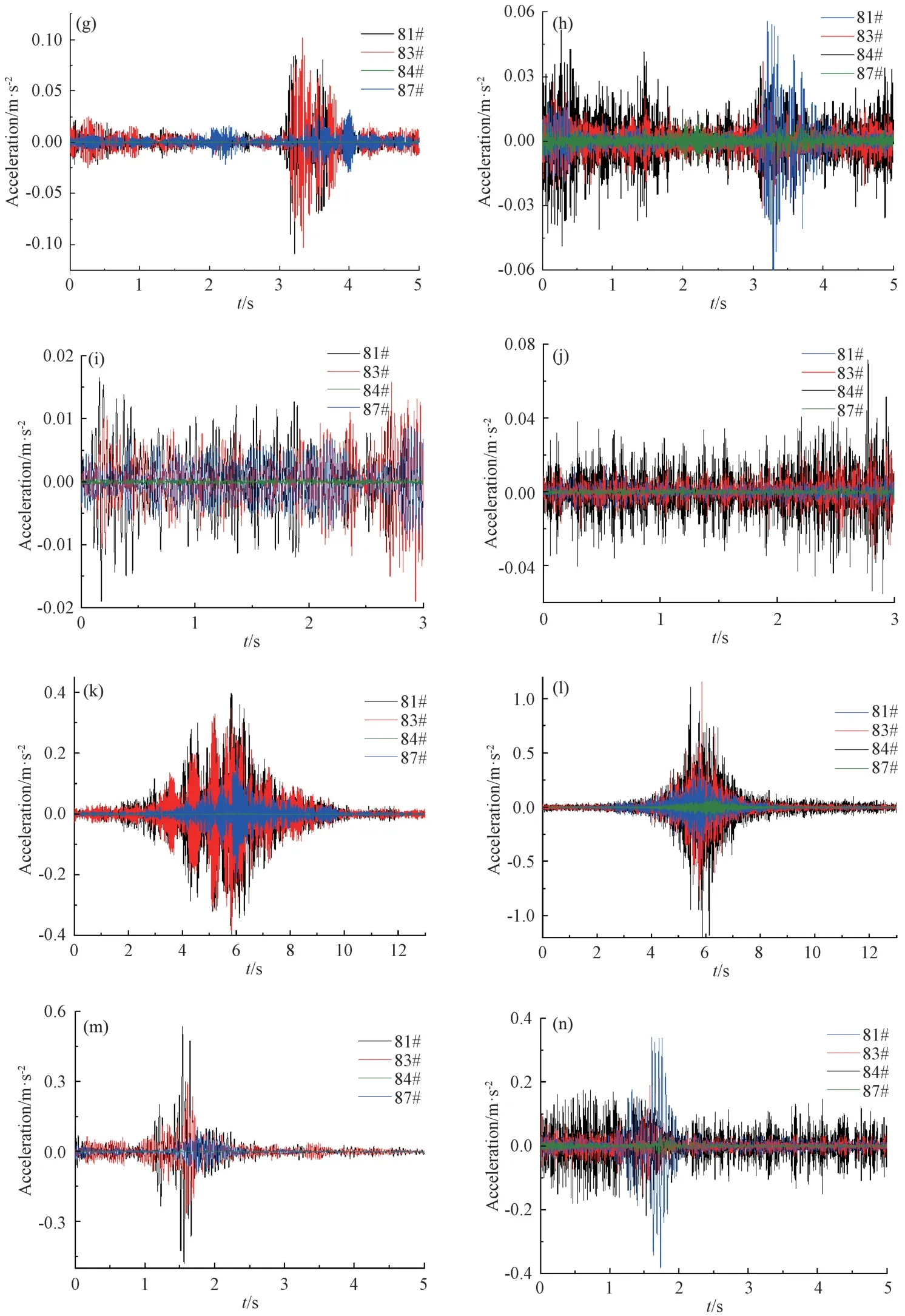
Figure 5 Acceleration monitoring curve
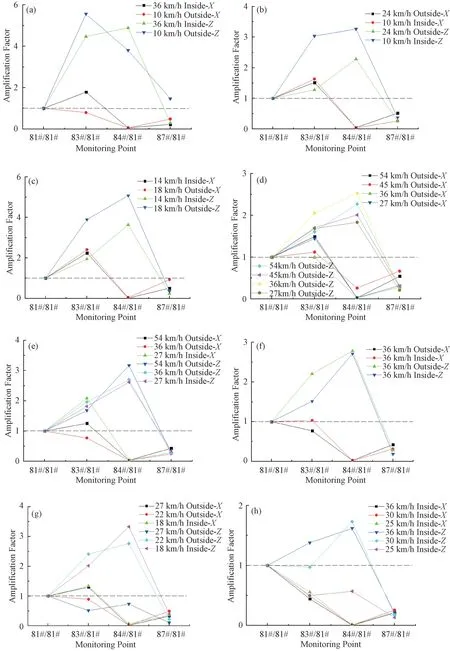
Figure 6 Vibration acceleration amplification factor
The results indicate that regardless of the slope stress state change caused by excavation and the degradation of rainfall on the properties of rock and soil,from the perspective of the impact of vehicle vibration alone,the double-sided loess slope close to the middle of the side slope of the road is the actual key protection areas in the project.Thus,the side slope gradient cannot be too large in the process of loess slope design.Furthermore,in the construction process,the excavation process on the slope structure should be avoided.
4.3 Vibration Frequency Analysis
Frequency is an important characteristic of wave propagation in the medium.In order to explore the frequency variation of vibration waves generated by different types of vehicles in the slope body,the frequency spectrum analysis of test signals is carried out by fast fourier transform algorithm,and the frequency spectrum characteristics of the slope under the action of automobile vibration are obtained (Figs.7 and 8).
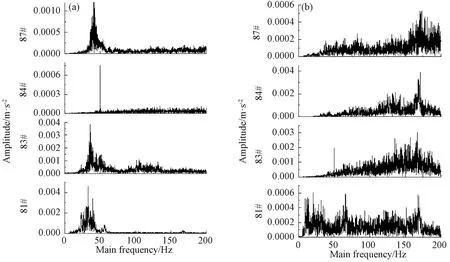
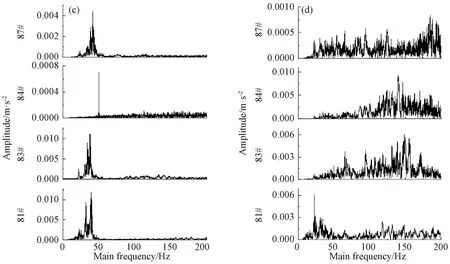
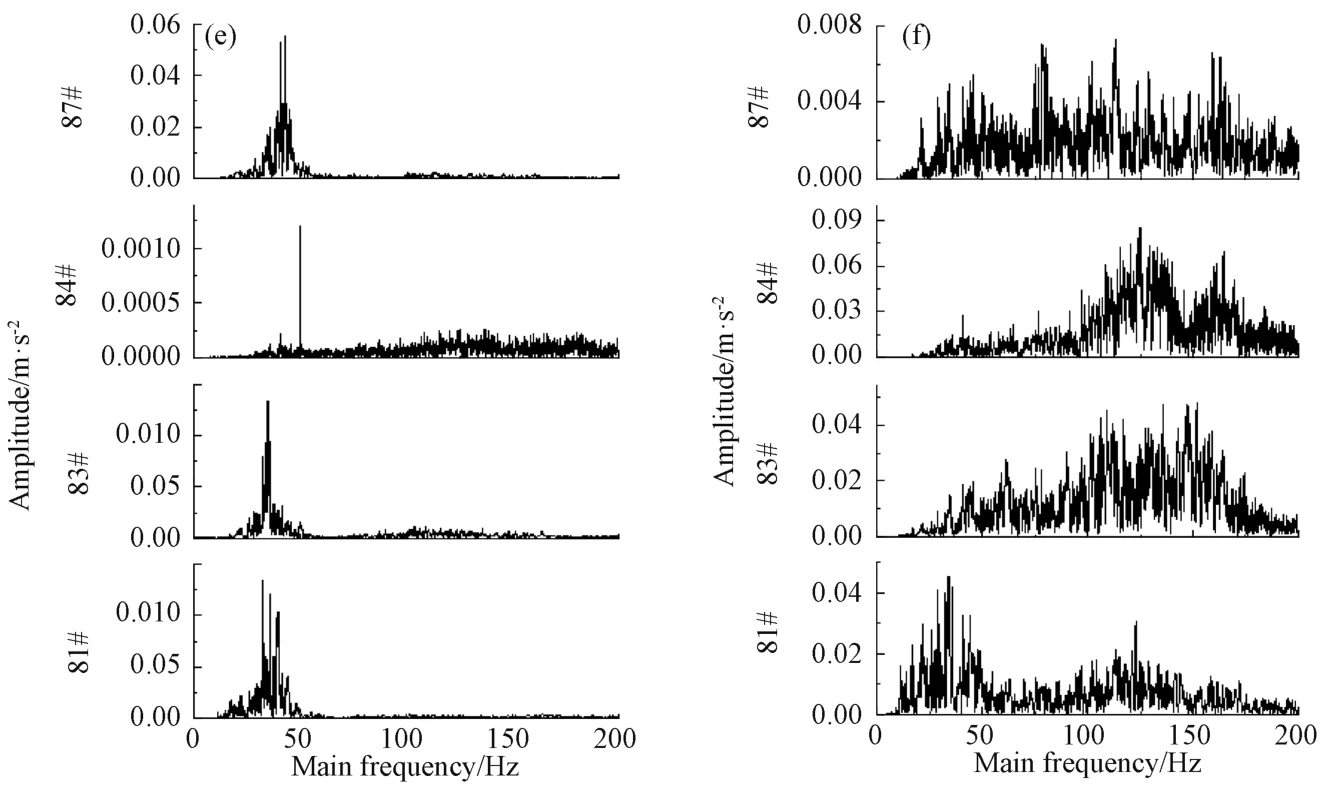
Figure 7 Slope spectrum analysis curve
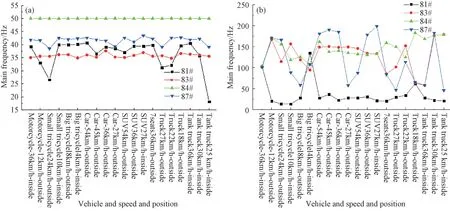
Figure 8 Vibration wave frequency comparison
It can be seen from the Fig.7 that the spectrum distribution of theX-direction wave is unimodal with energy concentrated between 30-50 Hz.By contrast,the spectrum distribution of theZ-direction wave is multi-peak,exhibiting relatively dispersed energy distribution in which the main frequency is concentrated between 20-180 Hz.
For theX-direction wave,regardless of vehicle type and speed,the main frequency of the wave from 81# to 87# monitoring points firstly moves to the low-frequency direction and then changes to the high-frequency direction.There is no single increase or decrease,and it reaches the maximum value at the monitoring point 84# and the minimum value at the monitoring point 83#.
The change of the main frequency of theZ-direction wave is relatively complex.On the slope close to the highway,the monitoring points from 81# to 84# move to the high frequency first and then convert to the low frequency.The change of the main frequency on the slope deviating from the highway is relatively complex and the regularity is not obvious.
When theX-direction wave generated by automobile vibration propagates inside the slope body,its vibration amplitude is also changing.Although its change rule is to decrease first and then increase,its magnitude value is lower than that of 81# monitoring point,indicating an obvious energy attenuation process.The vibration amplitude variation of theZ-direction wave is obviously different from that of theX-direction wave,suggesting that the amplitude increases first and then decreases.The amplitude increases significantly on the slope near the highway side with an enhanced vibration response,but the vibration response on the other side of the slope body is somewhat weakened.
5 CONCLUSION
(1) The dynamic response of a loess slope caused by vehicle vibration increases as its load increases.TheX-direction wave has the strongest vibration response in the middle of the slope on the side of the road,and the weakest response on the top of the slope.The position of vehicles has a more obvious influence on the vibration response than the speed.The vibration response of theZ-direction wave increases from the foot of the slope to the top of the slope.The location and speed of the vehicle are determined together,showing a“whiplash effect”.
(2) During the propagation process,the energy attenuation of theX-direction wave from the foot of the slope to the top of the slope is obvious; the energy of theZ-direction waves near the side slope of the highway increases significantly,but attenuates on the other side of the slope.
(3) For theX-direction waves,the main frequency of the slope from the near-road side to the other side moves in the low-frequency direction first,then changes into the highfrequency direction,and reaches the maximum value at the top of the slope,with the main frequency concentrated between 30 and 50 Hz.
The main frequency variation of theZ-direction wave is relatively complex.From foot to top,the slope near the highway side first moves in the direction of high frequency and then transforms to the direction of low frequency.When it deviates from the side of the highway,the regularity is not obvious,and the main frequency concentrates between 20-180 Hz.
(4) In the process of the wave propagation,the energy attenuation phenomenon of theX-direction wave from the slope foot to the slope top is relatively obvious; on the other hand,the slope energy of theZ-direction wave increases obviously on one side near the highway,but decreases on the other side.
(5) Vehicle vibration will form a large tensile stress area on a double-sided loess slope near the middle of one side of the road,resulting in possible deformation and damage of the slope.
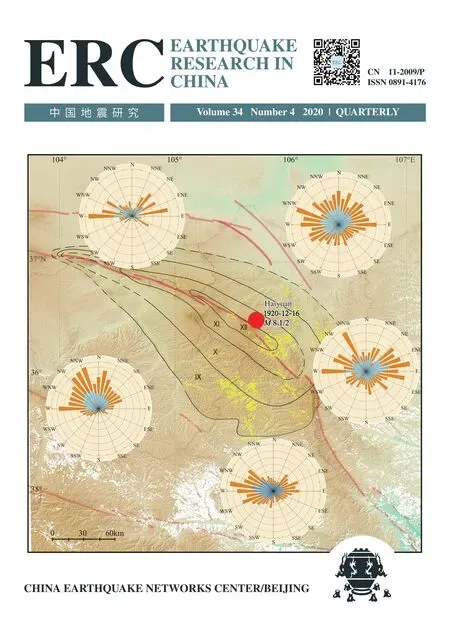 Earthquake Research Advances2020年4期
Earthquake Research Advances2020年4期
- Earthquake Research Advances的其它文章
- Flow Characteristics of Large-Scale Liquefaction-Slip of the Loess Strata in Shibei Tableland,Guyuan City,Induced by the 1920 Haiyuan M8 Earthquake
- Dynamic Response of Shallow-Buried Tunnels Traversing High Loess Slopes
- Early Identification of the Jiangdingya Landslide of Zhouqu Based on SBAS-InSAR Technology1
- Interpretation of the Spatial Distribution Characteristics of the Co-seismic Landslides Induced by the 1920 Haiyuan M8 Earthquake Using Remote Sensing Images1
- Relationship between the Landslides Triggered by the Tongwei M7 Earthquake in 1718 AD and the Disappearance of Yongning Ancient Town
- Impact of the Rainfall Intensity and Seepage on Slope Stability in Loess Plateau1
